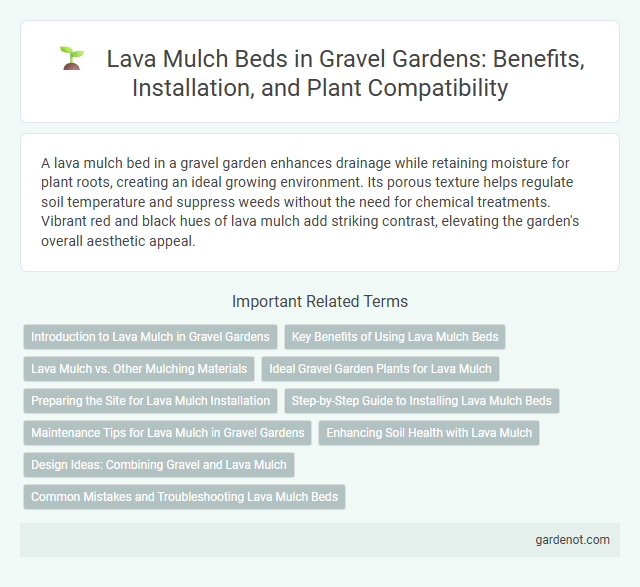A lava mulch bed in a gravel garden enhances drainage while retaining moisture for plant roots, creating an ideal growing environment. Its porous texture helps regulate soil temperature and suppress weeds without the need for chemical treatments. Vibrant red and black hues of lava mulch add striking contrast, elevating the garden's overall aesthetic appeal.
Introduction to Lava Mulch in Gravel Gardens
Lava mulch, composed of porous volcanic rock, offers exceptional drainage and aeration in gravel gardens, promoting healthy root growth. Its natural reddish color enhances aesthetic appeal while suppressing weed growth and retaining moisture effectively. Incorporating lava mulch in gravel garden beds improves soil structure and reduces erosion, making it an ideal choice for sustainable landscaping.
Key Benefits of Using Lava Mulch Beds
Lava mulch beds significantly improve soil aeration and drainage, preventing root rot and promoting healthier plant growth in gravel gardens. Their natural porous structure retains moisture while reducing evaporation, supporting drought-tolerant landscaping. The mineral content in lava mulch also enriches soil nutrients over time, enhancing plant vitality and sustainability.
Lava Mulch vs. Other Mulching Materials
Lava mulch offers superior drainage and aeration compared to traditional organic mulches, making it ideal for gravel gardens where moisture control is critical. Its porous structure prevents soil compaction and supports root health, unlike heavier materials like bark or rubber mulch that can retain excess moisture and promote fungal growth. Durable and long-lasting, lava mulch eliminates the need for frequent replacement common with organic mulches, providing an eco-friendly, low-maintenance solution.
Ideal Gravel Garden Plants for Lava Mulch
Ideal gravel garden plants for lava mulch beds include drought-tolerant succulents such as Sedum, Agave, and Sempervivum, which thrive in well-drained, nutrient-poor soils. Mediterranean herbs like lavender, rosemary, and thyme also flourish, benefiting from the mulch's excellent heat retention and moisture conservation. These plants not only complement the bold texture of lava mulch but also require minimal maintenance, making them perfect for sustainable landscaping.
Preparing the Site for Lava Mulch Installation
Clear the gravel garden area by removing weeds, debris, and any existing mulch to create a clean surface for the lava mulch bed. Level the soil and improve drainage by loosening compacted ground and adding a layer of landscape fabric to prevent weed growth. Ensure the site is dry and well-drained to promote the longevity and effectiveness of the lava mulch installation.
Step-by-Step Guide to Installing Lava Mulch Beds
Prepare the area by clearing debris and leveling the soil to ensure proper drainage for the lava mulch bed. Lay a landscape fabric over the prepared soil to prevent weed growth while allowing water to penetrate. Evenly spread a 2-3 inch layer of lava mulch on top of the fabric, creating a durable, breathable, and decorative mulch bed ideal for gravel garden designs.
Maintenance Tips for Lava Mulch in Gravel Gardens
Lava mulch in gravel gardens requires periodic raking to prevent compaction and promote aeration, ensuring optimal moisture retention for surrounding plants. Removing debris and fallen leaves regularly helps maintain its porous structure, which supports healthy root growth and reduces weed proliferation. Applying a weed barrier fabric beneath the lava mulch further minimizes maintenance by preventing weed seeds from germinating in the gravel garden bed.
Enhancing Soil Health with Lava Mulch
Lava mulch improves soil health by enhancing aeration and moisture retention in gravel garden beds. Its porous structure promotes beneficial microbial activity, which supports nutrient cycling and root growth. Over time, lava mulch helps maintain balanced soil temperature and reduces erosion, fostering a resilient garden ecosystem.
Design Ideas: Combining Gravel and Lava Mulch
Combining gravel and lava mulch creates a visually striking gravel garden bed with enhanced texture and color contrast. Lava mulch's porous structure improves drainage while complementing the smooth, polished look of gravel, promoting plant health and aesthetic balance. Using varying sizes and colors of both materials accentuates focal points and pathways, adding depth and dimension to garden design.
Common Mistakes and Troubleshooting Lava Mulch Beds
Lava mulch beds often suffer from poor drainage and soil compaction, which can lead to root rot and plant stress. Common mistakes include overapplying lava mulch too thickly, causing water retention issues, and neglecting to periodically aerate the bed to maintain healthy soil structure. Troubleshooting involves carefully adjusting mulch depth to around 2-3 inches and ensuring proper irrigation practices to prevent excess moisture buildup.
Lava mulch bed Infographic

 gardenot.com
gardenot.com